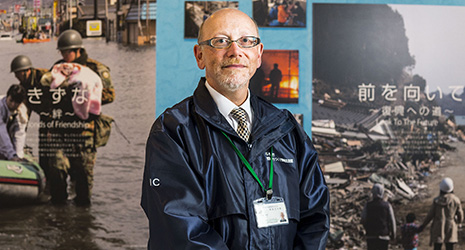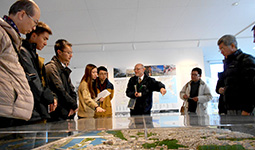Home > Highlighting JAPAN > Highlighting Japan February 2017 > Home Away from Home
Highlighting JAPAN


Sharing the Lessons Learned from Disaster
Briton Richard Halberstadt is enjoying a new life in northeastern Japan as director of the Ishinomaki Community and Information Center.
The Great East Japan Earthquake and subsequent tsunamis of 11 March 2011 claimed the lives of more than 19,000 people. Ishinomaki, a port city in northeastern Miyagi Prefecture, felt the full force of the enormous tsunamis, the highest of which measured 8.6 meters.
In 2015, Ishinomaki City established the Ishinomaki Community and Information Center as a place where local residents and visitors could interact and share the information and lessons learned. The director of the Information Center is Richard Halberstadt.
“The number of visitors to the Information Center since its opening has exceeded 34,000, and over 1,500 of them were from outside of Japan,” says Halberstadt. “I feel a sense of fulfillment when people from overseas say that this is the only place where they can hear the stories of the affected areas in detail, in English.”
Halberstadt studied Japanese language at a university in Britain and in 1993 was appointed by Ishinomaki Senshu University to be an English teacher. Around that time, a project was carried out in Ishinomaki as part of its community revitalization initiatives. This project was about the reconstruction of the wooden sailing vessel, the San Juan Bautista, which was used approximately 400 years ago by the Sendai Domain that ruled present-day Miyagi Prefecture and areas beyond, in order to dispatch delegates to Spain for the purpose of trade negotiations. The Junior Chamber of Ishinomaki also organized a stage play about the San Juan Bautista to coincide with the project. Halberstadt appeared on stage in the role of the foreign engineer who taught the people how to construct the vessel. He made a lot of friends through this experience, which enabled him to establish a strong bond with Ishinomaki. He subsequently joined the Junior Chamber and started to become involved in the community revitalization initiatives.
Halberstadt was at work on the campus when the earthquake of 11 March 2011 struck. The tsunamis left him stranded, surrounded by water, for two days during which anxious time he relied on radio broadcasts for information. On the third day, he was rescued by his best friend, who came to the campus to help. This was when he learned about the death of a couple who had been among his closest friends.
“Immediately after the earthquake, everyone was in an extreme state, simultaneously experiencing both the joys of survival and reunion, as well as the sorrows of losing their loved ones,” recalls Halberstadt. “Even in a state of calamity, people helped one another at the shelters.”
The British Embassy issued an evacuation advisory around this time, and Halberstadt departed for Sendai, the capital of Miyagi Prefecture, intending to fly back to Britain. However, he was unable to put the people of Ishinomaki out of his mind. He spent the whole night pondering what to do. Deciding that he would regret returning to Britain for the rest of his life, the following morning he headed back to Ishinomaki.
After the earthquake, the life of Halberstadt changed completely. As a foreign national who decided to stay in the affected area and devote himself to reconstruction efforts, he started to receive requests for interviews and lectures, and to publish a book. He subsequently decided to quit the teaching position that he had held for a long time at the university to accept an offer from the mayor of Ishinomaki who wished to appoint him to be the director of the Information Center.
“Even after experiencing the devastating impact of the earthquake, the people in Ishinomaki who experienced tsunamis many times in the past are positive, lively and cheerful,” says Halberstadt. “I was, if anything, cautious by nature, but after experiencing the earthquake, I have become more broad-minded. I can now think more optimistically about things.”
Soon six years will have passed since the earthquake, and the appearance of Ishinomaki is changing dramatically. New rows of housing for people who lost their houses due to the disaster have been constructed and a community hospital has newly opened in front of the station. Prior to the earthquake, Ishinomaki faced issues of depopulation in the city center, as well as the aging population in general. Halberstadt expects that the city will be revitalized following the new community initiatives.
“Ishinomaki is not a tourist destination crammed with a lot of attractions. Instead, you can appreciate the beauty of ordinary life in Japan here. It is indeed a wonderful place,” says Halberstadt. “I hope people who think they reside in a country unlikely to be hit by natural disasters will come to the Information Center to learn about disaster risk reduction.”
© 2009 Cabinet Office, Government of Japan







